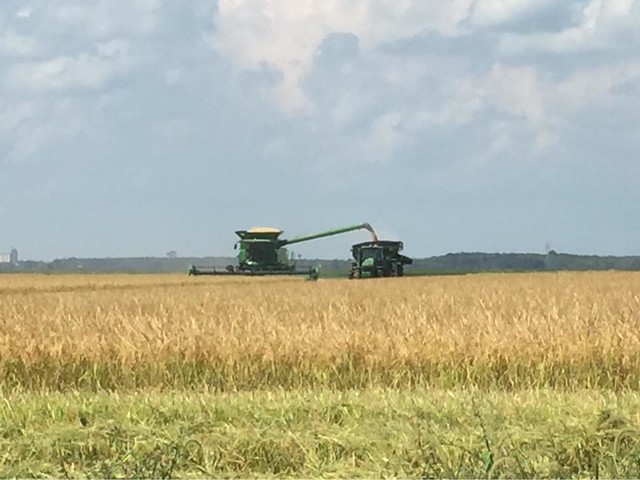NASS projects records in Arkansas corn, cotton, sorghum, soybeans
By Mary Hightower
U of A System Division of Agriculture
Fast facts
-
- NASS projecting record high yield for Arkansas soybeans, corn, sorghum, cotton
- NASS projecting second highest yields in U.S. for corn, grain sorghum
- Corn, soybean contracts finish down at end of day
(620 words)

JONESBORO, Ark. – Just as combines begin to scratch the surface of the 2015 harvest, the U.S. Department of Agriculture’s National Agricultural Statistics Service on Wednesday projected record high yields for Arkansas soybeans, sorghum, corn and cotton.
Soybeans were projected to yield 53 bushels per acre, which would be a new state average
record, up three bushels from last year. Arkansas growers planted 3.2 million acres
of soybeans, down 1.2 percent from the previous year. A 53-bushel-an-acre yield would
tie Arkansas with Illinois, second only to Nebraska’s projected 56 bushels per acre.
Jeremy Ross, extension soybean agronomist for the University of Arkansas System Division of Agriculture, said the 53-bushel-per-acre forecast took him by surprise.
“We had record yields the last two years, but July and August 2015 were much, much hotter and drier than they were the last two years and that’s affecting yields,” he said. “And a large percentage of acreage in the northern part of the state was planted extremely late — a lot later than the last two years. That’s two strikes against us for high yields.”
Ross said he was “predicting in the mid- to upper-40s for the state yield. I just don’t see us hitting 53 bushels an acre.”
NASS is projecting a record Arkansas’ corn yield at 195 bushels per acre from 470,000 harvested acres, well up from last year’s 187 bushels per acre. The 195 bushels would make Arkansas second only to Washington State’s projected 220 bushels per acre.
Arkansas’ cotton crop was projected to yield 1,226 pounds of lint per acre, up 81 pounds from last year, and a new record. However, cotton acreage was projected to be down 95,000 acres from last year, to 235,000 acres. “If realized this would be the lowest harvested acres on record in the state,” according to the NASS report.
Arkansas’ sorghum yield is projected at a record 105 bushels an acre on 480,000 harvested acres. If realized, Arkansas would have the nation’s second highest state average yield to Illinois’ projected 109 bushels per acre. That compares with last year’s 97 bushels per acre over 165,000 harvested acres.
Rice production was forecast down from 112 million hundredweight last year to 105 million this year.
From bulls to steers
“Traders were shocked by the bearish numbers and the USDA’s higher yield and production estimates,” said Scott Stiles, extension economist for the University of Arkansas System Division of Agriculture. “Grain bulls were steers by the end of today’s trading.”
November soybeans finished 61½ lower at $9.10. September and December corn futures were both down a shade over 19 cents. September rice lost 8 cents to finish at $11.71. Next July wheat was down 15½ cents settling at $5.12 ½. Cotton was the only winner today with December contract up 288 points to close at 64.70.
Ahead of today’s report the average trade guess had U.S. corn yield dropping 2.4 bushels per acre from July. The soybean yield estimate was projected drop to 44.6 bushels, down from 46 last month. The August report pegged the U.S. corn and soybean yields at 168.8 and 46.9 bushels per acre respectively.
“With expectations for lower yields, ending stocks for both corn and soybeans were also expected to decline,” Stiles said. “That didn’t happen either.”
Soybean ending stocks for the 2015/16 marketing year increased from 425 million bushels last month to a projected 470 million bushels. Corn ending stocks increased from about 1.6 billion bushels to more than 1.7 billion—well above the pre-report guess of 1.427.
“After the release of these numbers, both markets sold off dramatically with soybeans
nearly trading limit down,” he said. “Corn prices held up better but still finished
the day lower.”
Stiles said wheat report numbers were actually close to pre-report expectations,
but price direction followed that of corn and soybeans.
To learn more crop production, contact your county extension office or visit www.uaex.uada.edu.
Pursuant to 7 CFR § 15.3, the University of Arkansas System Division of Agriculture offers all its Extension and Research programs and services (including employment) without regard to race, color, sex, national origin, religion, age, disability, marital or veteran status, genetic information, sexual preference, pregnancy or any other legally protected status, and is an equal opportunity institution.
# # #
Media Contact: Mary Hightower
Dir. of Communication Services
U of A Division of Agriculture
Cooperative Extension Service
(501) 671-2126
mhightower@uada.edu
Related Links